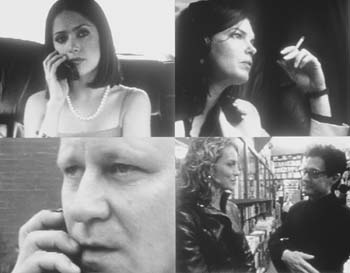![[Metroactive Movies]](/movies/gifs/movies468.gif)
[ Movies Index | Show Times | San Jose | Metroactive Central | Archives ]
Figgis' Four-by-Four
Experimental split-screen 'Time Code' takes place four times at once
By Richard von Busack
MIKE FIGGIS' experimental film Timecode boasts a novel gimmick: it was shot with four cameras, whose images are projected simultaneously on the screen. This may be the first all-split-screen release since MGM's 1973 slasher film Wicked, Wicked ("in Duo-vision"). Time Code also vaunts its digital-camera technology--which is commonplace, though no director has used it with such a sturdy sense of composition.
Once again, Figgis (best known for Leaving Las Vegas) is examining the forces of synchronicity and coincidence, the subject of his misbegotten last film, The Loss of Sexual Innocence. The film is set in real time, taking place for the most part in one Sunset Strip building and on the sidewalk in front of it. Pared down, the narrative is a love quadrangle interrupted by a series of strong earthquakes.
The main focus is a blow-up between two lovers: a seething, jealous, wealthy older woman, Lauren (Jeanne Tripplehorn), and her younger, and apparently kept, girlfriend Rose (Salma Hayek). Lauren flattens Rose's tire to make sure that she can drive the girl to her audition, for some sort of New Jack soft-core garbage film titled Bitch From Louisiana, which is in development by Red Mullet, a small and desperate film production company.
One of Red Mullet's producers, Alex (Stellan Skarsgard), is in crisis, having just been left by Emma (Saffron Burrows), the woman he loves. Alex is also in mid-affair with the demanding Rose. Emma's wanderings, Lauren's rage, and Alex and Rose's desperation come to a deadly climax.
Time Code is semi-improvised and looks it. Some of the lines have the forced whimsy of porn-film dialogue, and actors like Julian Sands and Holly Hunter are used essentially as celebrity cameos. Figgis claims that his quartered-screen technique transcends montage, but the steady flow of sequential images is so essential to the language of cinema that his assertion is like claiming, "I'm going to write without syllables."
Quadro-vision, or whatever you'd like to call it, lies somewhere between silent and sound film. Thus it depends on the emoting quality of second-rate performers like Tripplehorn and Burrows. Tripplehorn is more forceful than usual. She could be building to some raging performance a picture or two down the line--remember how loudly and intensely she acted in her angry scenes in the dumb farce Mickey Blue Eyes? Here, Figgis leaves her stewing too long. Not cutting away for an hour and a half proves one of the virtues of montage: to give the audience a break from an actor's face.
Behind the avant-garde technique, Time Code is a Hollywood satire too specific to lure a viewer past the intimidating gimmick. Too often, the film has the same problem that plagues TV viewers in a fringe reception area: four channels and nothing's on.
[ San Jose | Metroactive Central | Archives ]
Copyright © 2000 Metro Publishing Inc. Metroactive is affiliated with the Boulevards Network.
For more information about the San Jose/Silicon Valley area, visit sanjose.com.
![]()

Meeting in the Quad: Four stories unfold simultaneously in Mike Figgis' tricky 'Time Code.'
Time Code (R; 97 min.), directed and written by Mike Figgis and starring Jeanne Tripplehorn, Salma Hayek and Saffron Burrows, opens Friday at Camera One in San Jose.
From the May 11-17, 2000 issue of Metro, Silicon Valley's Weekly Newspaper.